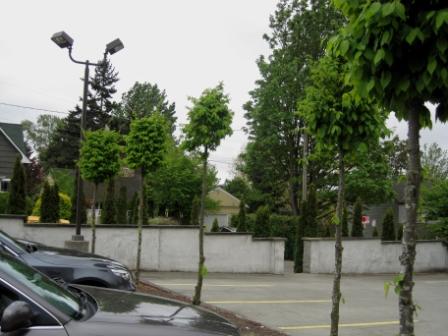Yesterday I received a call from an administrator at a large military base. (I have to tell you that anytime I get a call from someone in government I immediately start wondering about “the file” that I’m sure is kept on me. No, I’m not paranoid, but I’m an outside reviewer for a number of graduate student theses from the University of Agriculture in Faisalabad, Pakistan. In fact, I’m doing two right now. So every once in a while I am sent a brown paper package from Pakistan. They’ve always been opened and resealed by the time I get them. But I digress.) Anyway, the administrator from the LMB was concerned about a newly installed landscape on the base. Requirements for landscapes around military buildings specify that plants must be placed a certain distance from the building itself, and not be tall enough to hide people or large objects. So my caller was concerned that the winter creeper (Euonymous fortunei) which had been planted would start to do exactly what its name implies. Furthermore, he had done a little Googling and found reports that this plant can get quite a bit taller than what the LMB specifications require. However, the landscaper was adamant that this plant would not exceed the height requirements and cited one of Dr. Michael Dirr’s books as evidence. So what, the caller asked, did I think about this?

Several years ago I wrote a myth column on plant size, which you can read here. Part of this column immediately sprung to mind: “The lack of consensus among tree identification guides, taxonomic literature, nursery tags, and real-life landscape specimens underscores the fallacy of assuming a uniform maximum height for any species, variety, or cultivar of any tree or shrub.” In fact, the best predictor for mature plant size – especially for nonnative species – is performance in your local geographic region. With this in mind, I called my colleague Dr. Sarah Reichard (an excellent plant taxonomist) at the University of Washington. She laughed when I explained the situation and said that a local specimen at the Washington Park Arboretum had become such a nuisance that the grounds crew had to whack it into submission. Not only was it well over 12” tall, but it had crept into the nearby Magnolia and was busy making itself at home.
 Don’t have a photo of the Magnolia-eating creeper, but I do have this nice truck-eating ivy.
Don’t have a photo of the Magnolia-eating creeper, but I do have this nice truck-eating ivy.
What about the Dirr book? It’s an excellent resource, but it doesn’t necessarily take into account how climatic differences can influence plant height. In contrast, the Western Garden Book (by Sunset magazine), though not an academic resource, does look at local plant performance in its descriptions. I was also annoyed to find that this introduced species is invading the eastern US and is considered a weed in some states. There are lots of good plant choices out there. Let’s not aid and abet the invasives.
So my caller was armed with definitive evidence and the landscaper will probably have to absorb the replacement costs. The lesson: don’t rely on books alone. Do some legwork in your area to find out what plants are up to – literally.
 Sidewalk-eating Japanese maple – not an invasive, but easily outgrows its “expected” space
Sidewalk-eating Japanese maple – not an invasive, but easily outgrows its “expected” space











 Don’t have a photo of the Magnolia-eating creeper, but I do have this nice truck-eating ivy.
Don’t have a photo of the Magnolia-eating creeper, but I do have this nice truck-eating ivy. Sidewalk-eating Japanese maple – not an invasive, but easily outgrows its “expected” space
Sidewalk-eating Japanese maple – not an invasive, but easily outgrows its “expected” space